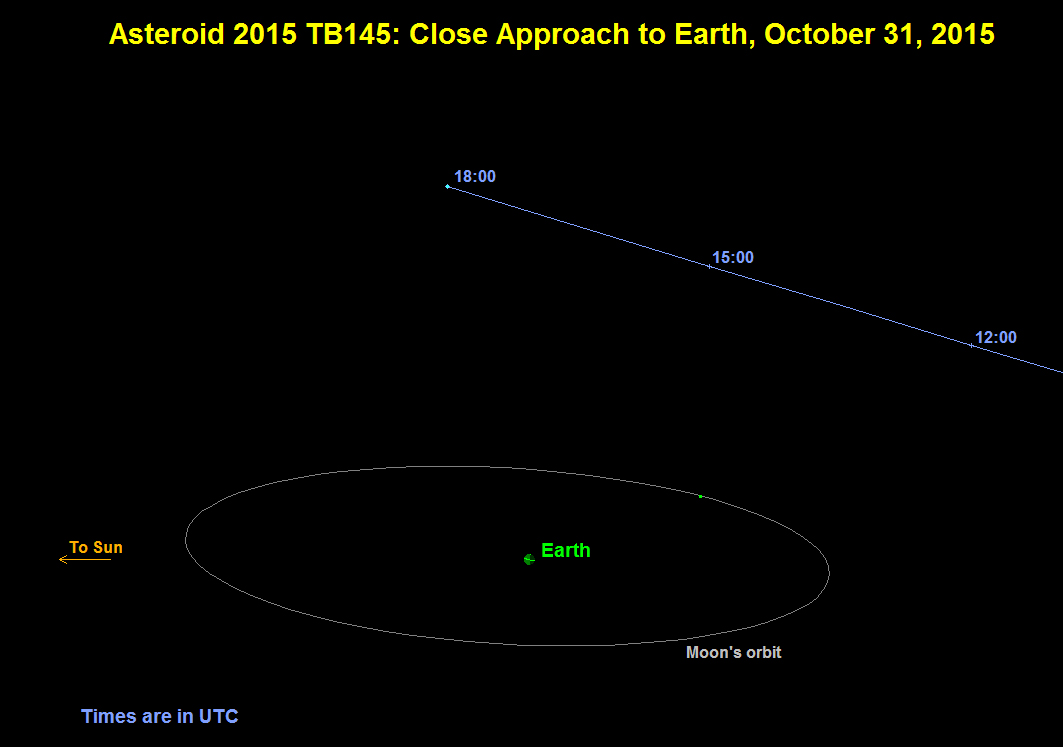Halloween Asteroid Flyby: Here's What We Know About 2015 TB145

As a big asteroid flies by at a close but safe distance from Earth on Saturday (Oct. 31), astronomers will likely get a better radar view of the surface than ever before.
Asteroid 2015 TB145 — discovered earlier this month, on Oct. 10 — will fly by slightly outside the moon's orbit. In celestial terms, this is rather close, especially considering the asteroid's size; at an estimated 1,300 feet (400 meters) wide, this is the closest known flyby by a large asteroid until 2027. TB145 will fly by at 300,000 miles (480,000 kilometers) from Earth, but poses no threat to our planet.
And that provides a special kind of Halloween treat for astronomers: the chance to view the surface in radar down to a resolution of as little as 2 meters (6.6 feet). Previous flybys yielded a resolution of about half that, 4 meters (13.1 feet). [Watch: Observatory Sees Halloween Asteroid 2015 TB14]
"What's particularly interesting is the number of boulders on the surface," Paul Chodas, the Jet Propulsion Laboratory's manager of the center of near-Earth object studies, told Space.com.
Among NASA's proposed long-term plans is an asteroid-redirect mission that would move a space rock (or perhaps a large piece of a space rock) closer to Earth for astronauts to explore. TB145 is not being considered for that mission because its orbit is highly tilted to the ecliptic, the plane in which the Earth and other planets in orbit. It would take a lot of energy to get there, and there are better asteroid candidates to consider, Chodas said.
What TB145 can do, however, is provide an example of what sorts of boulders are on an asteroid's surface, Chodas added. "They want to know in general how the asteroids are built, what is their structure, what is their strength, what is the surface distribution of boulders, how many are there, and how well they're held to the surface."
Tough to find
TB145 was detected by the University of Hawaii's Pan-STARRS-1 telescope (the name's short for Panoramic Survey Telescope and Rapid Response System), which participates in NASA's near-Earth object observation program. According to the Minor Planet Center, this will be the closest known flyby of an asteroid of this size until 2027, when asteroid 1999 AN10 (about 2,600 feet, or 800 meters in size) flies by at about the orbit of the moon.
Breaking space news, the latest updates on rocket launches, skywatching events and more!
"We're not calling the asteroid spooky, even though I've heard some people calling it that," Chodas joked about the Halloween arrival. "To us, it's just TB145, and eventually the Pan-STARRS group will have the right to give it an official name."
TB145's weird, elliptical path through space brings it close to the Earth's orbit once every three years. But its brush with us is brief, usually a quick dip in and out before flying farther out in the solar system again. Astronomers think that perhaps past gravitational interactions with Jupiter threw it on the bizarre path.
The asteroid, however, has not come this close to Earth in about 40 years, according to the calculations astronomers ran on its orbit. In 1975, there wasn't really a dedicated search for asteroids and the technology was not as advanced to find asteroids of this size, Chodas said.
Little is known right now about its composition — optical telescopes will observe its spectral signature in a few days — or where its orbit will take it past the next 100 years. Chodas said once the radar telescopes at the Goldstone Deep Space Communications Complex in California and the Arecibo Observatory in Puerto Rico look at the asteroid, among other observatories, very detailed information about its orbit will be available.
Astronomers also aim to get more information about TB145's shape, and how it spins when the sun's heat hits its surface. Asteroids tend to spin at inconstant rates, and sometimes regolith (asteroid surface material) can migrate to the equator and fly off, Chodas said.
Follow Elizabeth Howell @howellspace, or Space.com @Spacedotcom. We're also on Facebook and Google+. Originally published on Space.com.

Elizabeth Howell (she/her), Ph.D., was a staff writer in the spaceflight channel between 2022 and 2024 specializing in Canadian space news. She was contributing writer for Space.com for 10 years from 2012 to 2024. Elizabeth's reporting includes multiple exclusives with the White House, leading world coverage about a lost-and-found space tomato on the International Space Station, witnessing five human spaceflight launches on two continents, flying parabolic, working inside a spacesuit, and participating in a simulated Mars mission. Her latest book, "Why Am I Taller?" (ECW Press, 2022) is co-written with astronaut Dave Williams.

